人教版(2019)选择性必修第二册Unit 1 Science and Scientists Using Language (I) 课件 (共17张PPT,内镶嵌视频)
文档属性
| 名称 | 人教版(2019)选择性必修第二册Unit 1 Science and Scientists Using Language (I) 课件 (共17张PPT,内镶嵌视频) | 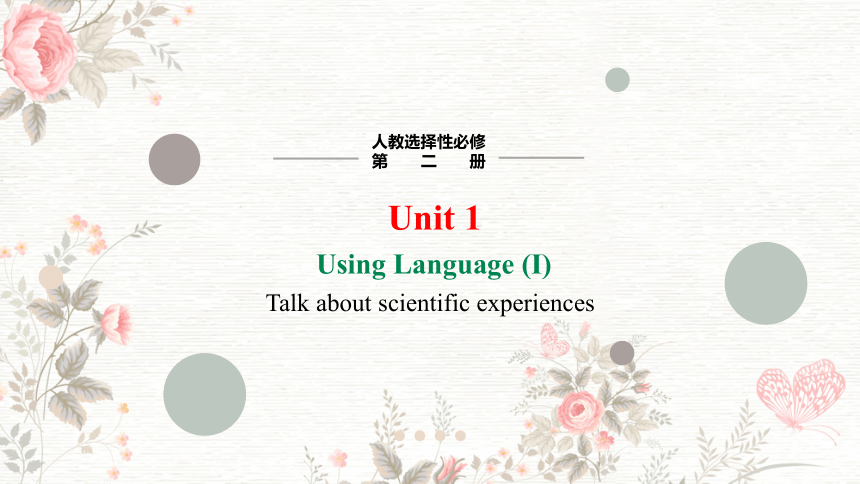 | |
| 格式 | pptx | ||
| 文件大小 | 23.7MB | ||
| 资源类型 | 教案 | ||
| 版本资源 | 人教版(2019) | ||
| 科目 | 英语 | ||
| 更新时间 | 2023-12-08 15:27:46 | ||
图片预览

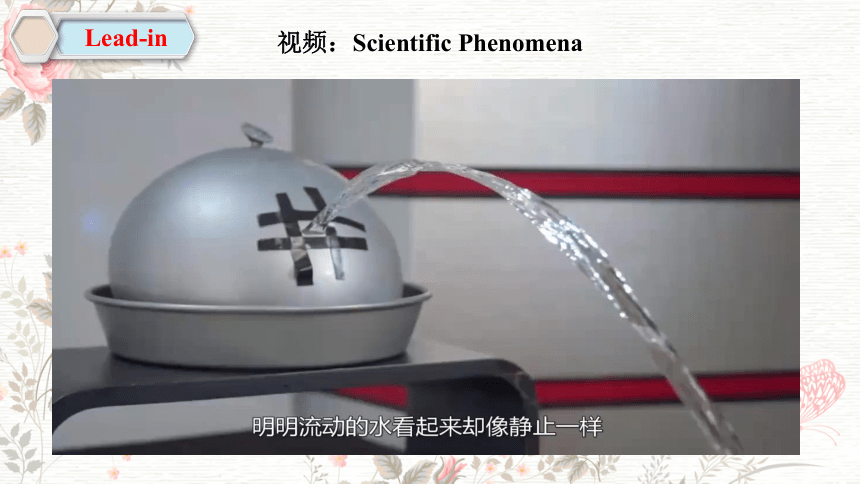
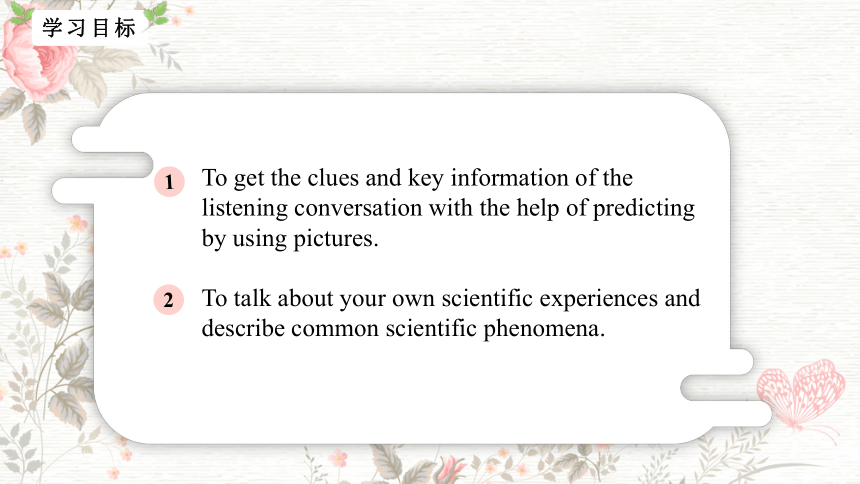
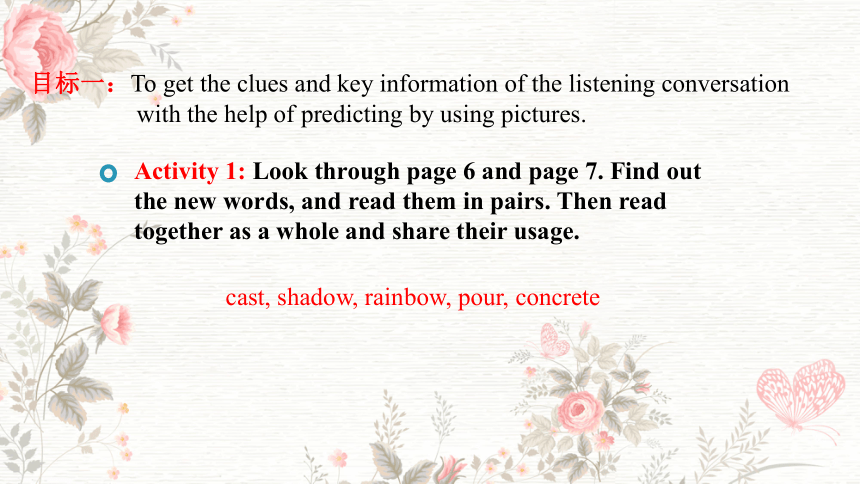
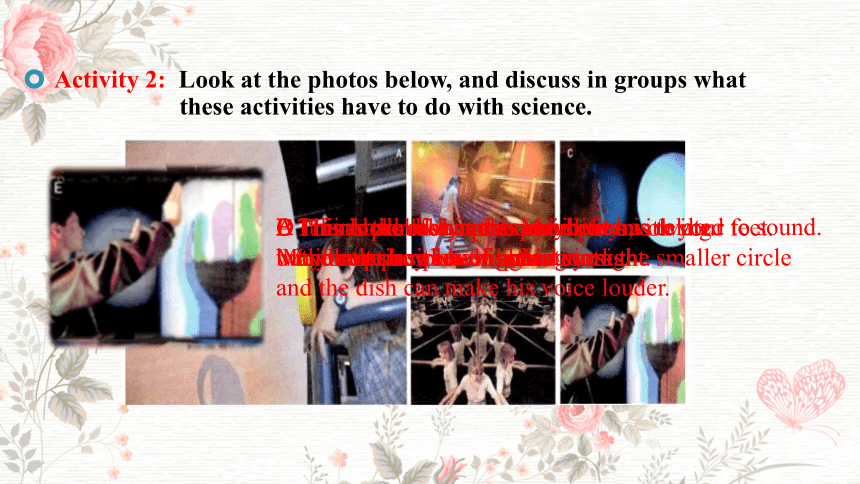
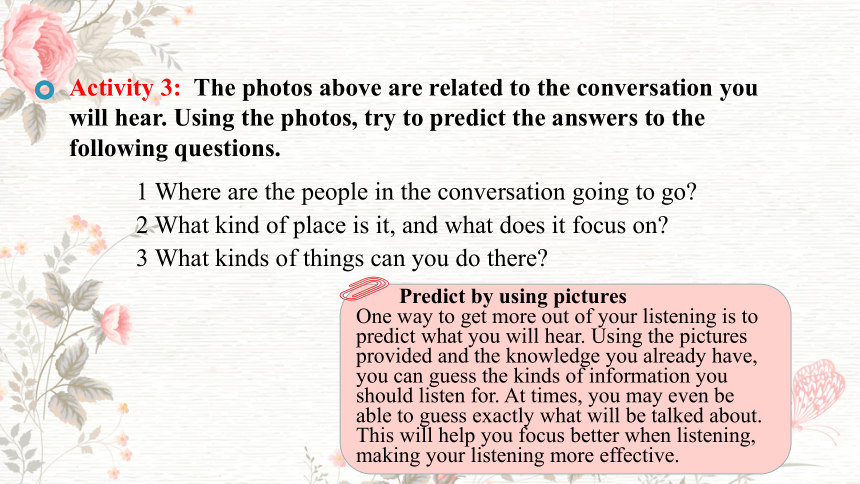
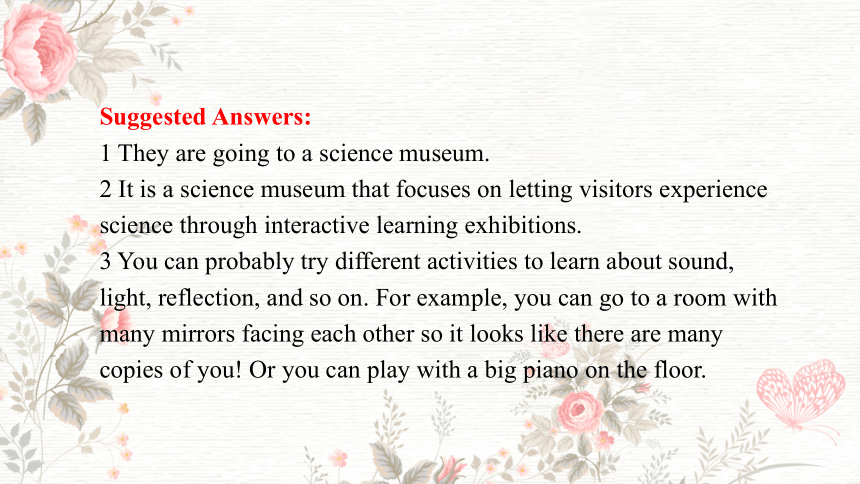
文档简介
(共17张PPT)
人教选择性必修第二册
Unit 1
Using Language (I)
Talk about scientific experiences
教学目
Lead-in
视频:Scientific Phenomena
1
2
To get the clues and key information of the listening conversation with the help of predicting by using pictures.
To talk about your own scientific experiences and describe common scientific phenomena.
目标一:To get the clues and key information of the listening conversation
with the help of predicting by using pictures.
Activity 1: Look through page 6 and page 7. Find out the new words, and read them in pairs. Then read together as a whole and share their usage.
cast, shadow, rainbow, pour, concrete
Activity 2: Look at the photos below, and discuss in groups what
these activities have to do with science.
A I think the dish in this exhibition is related to sound.
Maybe the boy is whispering into the smaller circle
and the dish can make his voice louder.
B This looks like a piano you play with your feet.
Maybe it shows how sound works.
C I'm not sure what this one shows,
but it must be about light or eyesight.
D It is a hall of mirrors. Maybe it has to do
with the principles of reflection.
E This is probably an experiment involving
the composition of light.
Activity 3: The photos above are related to the conversation you will hear. Using the photos, try to predict the answers to the following questions.
1 Where are the people in the conversation going to go
2 What kind of place is it, and what does it focus on
3 What kinds of things can you do there
Predict by using pictures
One way to get more out of your listening is to predict what you will hear. Using the pictures provided and the knowledge you already have, you can guess the kinds of information you should listen for. At times, you may even be able to guess exactly what will be talked about. This will help you focus better when listening, making your listening more effective.
Suggested Answers:
1 They are going to a science museum.
2 It is a science museum that focuses on letting visitors experience science through interactive learning exhibitions.
3 You can probably try different activities to learn about sound, light, reflection, and so on. For example, you can go to a room with many mirrors facing each other so it looks like there are many copies of you! Or you can play with a big piano on the floor.
Activity 4: Task 1 Listen to the conversation and see if your answers for Activity 2 are correct. Then write down the letters (A-E) for the photos in the order that you hear them described.
1._________ 2._________ 3._________
4._________ 5._________
D
C
E
B
A
Activity 4: Task 2 Listen again and complete the descriptions of the photos above.
Photo A: A giant dish; when you speak into it, it _______ the sound back and
_____________. You can use it to speak in a_______ to someone 17
metres away,
Photo B: A giant ____________ that you can use your feet to play. Instead of
playing the sounds of a piano, it plays the voices of _____________.
Photo C: You look at a blue screen for a while, and then suddenly you can see
______________ moving around on it. These are our ____________.
Photo D: A ____________ where you can see yourself reflected thousands of
times.
Photo E: You stand in front of ____________ and it casts different shadows of
you, in ____________ the rainbow.
reflects
makes it louder
whisper
piano keyboard
classical singers
tiny bright lights
own blood cells
hall of mirrors
a white light
every colour of
What scientific phenomenon does Picture A/B/C/D/E show
Did you guess correctly
How did you make the guess /Why didn't you guess correctly
A sound/light phenomenon.
目标二:To talk about your own scientific experiences and describe common
scientific phenomena.
Activity 1: Discuss the following questions in groups.
1 The conversation is about the City of Science and Industry,
a museum in Paris. Would you like to go to this museum
Why or why not
2 Are there any museums like this in China What other
interesting museums are there
Suggested Answers:
1 Yes. The exhibitions seem really interesting. I think I would learn a lot there.
2 Yes. For example, there is the China Science and Technology Museum in Beijing and the Shanghai Science and Technology Museum.
Activity 2: In groups, choose one of the museum activities on the previous page or brainstorm another scientific research or experiment that you are interested in. Use the phrases below to help you.
Talking about scientific phenomena
... can/cannot exist in the form of a solid/gas and a liquid/plasma ...
... Is both a ... and a... at the same time ... how light/sound is reflected ...
... the existence of other…This occurs when ...If you ....it will become ....That demonstrates ….This experiment/research shows... Through this, we know that ...We can prove that ...This evidence proves…
A scientific phenomenon/experiment
Name
Materials needed
Theory behind it
Process
Significance
...
After discussing and complete the chart.
Activity 3: Make a short presentation to the class about your choice.
Use the example below to help you.
EXAMPLE
Today, I want to talk to you about a very strange phenomenon called a non-Newtonian fluid. You can make it easily using equal parts of water and cornflour, like I have here. Anon-Newtonian fluid is strange because you can pour it like a liquid, but if you put any pressure on it, it suddenly becomes hard as concrete. In fact, it becomes hard enough to stand on. Then, as soon as you take the pressure off, it becomes a liquid again. This shows that it is possible that something can exist as a liquid and a solid at the same time.
Sample Presentation:
Today, I want to talk to you about the positive and negative charges of molecules. We can demonstrate how these interact through a simple experiment using milk, dish soap, and food colouring. First, cover the bottom of a shallow plate with milk. Now add two or three drops of different liquid food colouring to the centre of the milk. They should form one large dark puddle in the middle of the milk. Now, dip a cotton swab into dish soap, and place it into the middle of the food colouring. You will see the colours quickly move to escape from the soap, making interesting and beautiful patterns. This happens because the dish soap molecules have a strong negative charge, and the milk molecules have a strong positive charge. Like magnets, these molecules are attracted to each other, and so they appear to move around on the plate, taking the food colouring with them, making it look like the colours are quickly moving to escape from the soap.
Pick out one or two good presentations(texts) for class display.
1. How can you predict the kinds of information
you should listen for
2. How to talk about scientific phenomena
人教选择性必修第二册
Unit 1
Using Language (I)
Talk about scientific experiences
教学目
Lead-in
视频:Scientific Phenomena
1
2
To get the clues and key information of the listening conversation with the help of predicting by using pictures.
To talk about your own scientific experiences and describe common scientific phenomena.
目标一:To get the clues and key information of the listening conversation
with the help of predicting by using pictures.
Activity 1: Look through page 6 and page 7. Find out the new words, and read them in pairs. Then read together as a whole and share their usage.
cast, shadow, rainbow, pour, concrete
Activity 2: Look at the photos below, and discuss in groups what
these activities have to do with science.
A I think the dish in this exhibition is related to sound.
Maybe the boy is whispering into the smaller circle
and the dish can make his voice louder.
B This looks like a piano you play with your feet.
Maybe it shows how sound works.
C I'm not sure what this one shows,
but it must be about light or eyesight.
D It is a hall of mirrors. Maybe it has to do
with the principles of reflection.
E This is probably an experiment involving
the composition of light.
Activity 3: The photos above are related to the conversation you will hear. Using the photos, try to predict the answers to the following questions.
1 Where are the people in the conversation going to go
2 What kind of place is it, and what does it focus on
3 What kinds of things can you do there
Predict by using pictures
One way to get more out of your listening is to predict what you will hear. Using the pictures provided and the knowledge you already have, you can guess the kinds of information you should listen for. At times, you may even be able to guess exactly what will be talked about. This will help you focus better when listening, making your listening more effective.
Suggested Answers:
1 They are going to a science museum.
2 It is a science museum that focuses on letting visitors experience science through interactive learning exhibitions.
3 You can probably try different activities to learn about sound, light, reflection, and so on. For example, you can go to a room with many mirrors facing each other so it looks like there are many copies of you! Or you can play with a big piano on the floor.
Activity 4: Task 1 Listen to the conversation and see if your answers for Activity 2 are correct. Then write down the letters (A-E) for the photos in the order that you hear them described.
1._________ 2._________ 3._________
4._________ 5._________
D
C
E
B
A
Activity 4: Task 2 Listen again and complete the descriptions of the photos above.
Photo A: A giant dish; when you speak into it, it _______ the sound back and
_____________. You can use it to speak in a_______ to someone 17
metres away,
Photo B: A giant ____________ that you can use your feet to play. Instead of
playing the sounds of a piano, it plays the voices of _____________.
Photo C: You look at a blue screen for a while, and then suddenly you can see
______________ moving around on it. These are our ____________.
Photo D: A ____________ where you can see yourself reflected thousands of
times.
Photo E: You stand in front of ____________ and it casts different shadows of
you, in ____________ the rainbow.
reflects
makes it louder
whisper
piano keyboard
classical singers
tiny bright lights
own blood cells
hall of mirrors
a white light
every colour of
What scientific phenomenon does Picture A/B/C/D/E show
Did you guess correctly
How did you make the guess /Why didn't you guess correctly
A sound/light phenomenon.
目标二:To talk about your own scientific experiences and describe common
scientific phenomena.
Activity 1: Discuss the following questions in groups.
1 The conversation is about the City of Science and Industry,
a museum in Paris. Would you like to go to this museum
Why or why not
2 Are there any museums like this in China What other
interesting museums are there
Suggested Answers:
1 Yes. The exhibitions seem really interesting. I think I would learn a lot there.
2 Yes. For example, there is the China Science and Technology Museum in Beijing and the Shanghai Science and Technology Museum.
Activity 2: In groups, choose one of the museum activities on the previous page or brainstorm another scientific research or experiment that you are interested in. Use the phrases below to help you.
Talking about scientific phenomena
... can/cannot exist in the form of a solid/gas and a liquid/plasma ...
... Is both a ... and a... at the same time ... how light/sound is reflected ...
... the existence of other…This occurs when ...If you ....it will become ....That demonstrates ….This experiment/research shows... Through this, we know that ...We can prove that ...This evidence proves…
A scientific phenomenon/experiment
Name
Materials needed
Theory behind it
Process
Significance
...
After discussing and complete the chart.
Activity 3: Make a short presentation to the class about your choice.
Use the example below to help you.
EXAMPLE
Today, I want to talk to you about a very strange phenomenon called a non-Newtonian fluid. You can make it easily using equal parts of water and cornflour, like I have here. Anon-Newtonian fluid is strange because you can pour it like a liquid, but if you put any pressure on it, it suddenly becomes hard as concrete. In fact, it becomes hard enough to stand on. Then, as soon as you take the pressure off, it becomes a liquid again. This shows that it is possible that something can exist as a liquid and a solid at the same time.
Sample Presentation:
Today, I want to talk to you about the positive and negative charges of molecules. We can demonstrate how these interact through a simple experiment using milk, dish soap, and food colouring. First, cover the bottom of a shallow plate with milk. Now add two or three drops of different liquid food colouring to the centre of the milk. They should form one large dark puddle in the middle of the milk. Now, dip a cotton swab into dish soap, and place it into the middle of the food colouring. You will see the colours quickly move to escape from the soap, making interesting and beautiful patterns. This happens because the dish soap molecules have a strong negative charge, and the milk molecules have a strong positive charge. Like magnets, these molecules are attracted to each other, and so they appear to move around on the plate, taking the food colouring with them, making it look like the colours are quickly moving to escape from the soap.
Pick out one or two good presentations(texts) for class display.
1. How can you predict the kinds of information
you should listen for
2. How to talk about scientific phenomena
